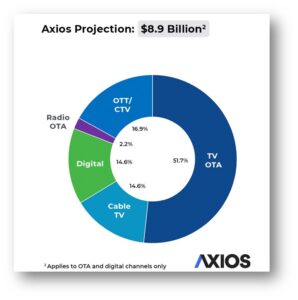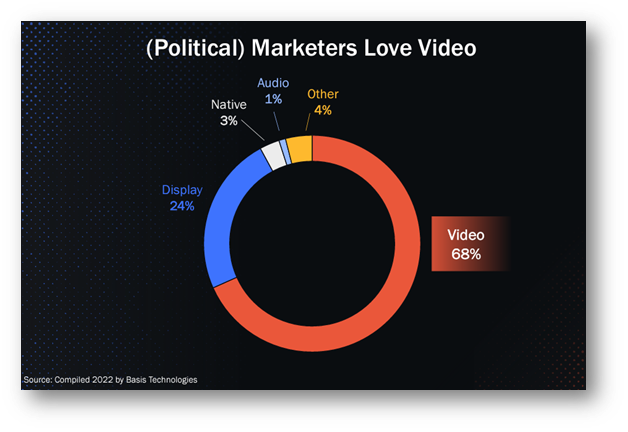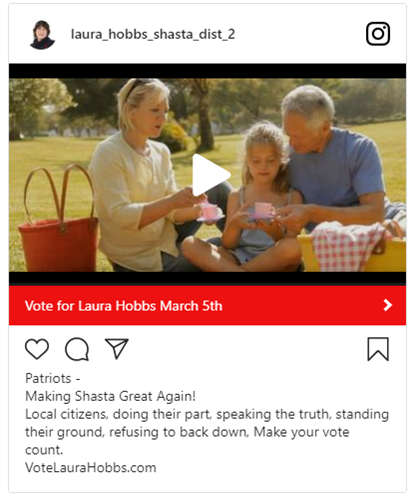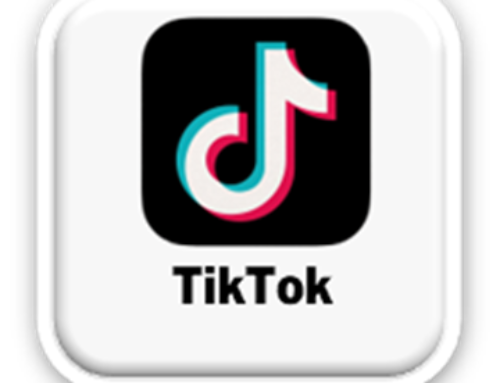It’s hard to believe that in just six months we will be voting for the 47th president of the United States, along with several other positions. It’s also hard to believe that the political ads have already started. It feels like we just got over them, and I’m already seeing and hearing political ads for everything from local school board elections to county elections. Gone are the days when political campaigns relied solely on traditional methods like billboards, yard signs, and TV ads to reach voters. In today’s world, where almost everyone is constantly connected to the internet, digital advertising has emerged as a formidable tool for political candidates to engage with voters, spread their message, and ultimately win elections.
Now is the time to start talking to political candidates about their campaigning plans for the 2024 election year because political ad spending is projected to be up 30% from 2020, and this projection has digital media getting 28% of the 2024 political season spend, which is nearly triple what candidates were spending on digital in 2020. Breaking it down even further, a large portion of digital budgets are projected to be spent with Over-the-Top (OTT) ads, second to traditional TV. The reach of digital advertising extends far beyond traditional boundaries. Unlike TV ads or billboards, which are limited by geography, digital ads can reach voters wherever they are, whether they’re at home, at work, or on the go. This omnipresence opportunity ensures that candidates can maintain a constant presence in voters’ lives, keeping their message top of mind throughout the campaign.
Another leg up that OTT has over regular TV ads is that the targeting options allow you to really drill down and target the ideal voter, like serving OTT ads to certain political categories through Behavioral Targeting like Political Donor: Democrat, Democratic Party Affiliation, Democrat, Democrat Voters, Super Democrats, Very Liberal/Hard Democrat, Somewhat Liberal/Leaning Democrat, Political Donor Propensity > Republican, Republican Party Affiliation, Very Conservative Political Outlook, Somewhat Conservative Political Outlook, Republican, Republican Voters, or Independent Voters, to name a few. You could also use some type of list to target voters. A list could be made up of past voters, an opponent’s voters list, or donor lists. You can even take those lists and create a lookalike audience so that now you are serving ads to people like those on the original list in order to broaden that reach.
I don’t think anyone will argue with me when I say that political candidates love using video. Outside of OTT ads, there are even more ways to use video ads with products like Video Pre-Roll/Mid-Roll Ads, Native Video, Facebook and Instagram, Mobile Conquesting (has limited inventory for video, but you could add on cross-platform targeting for more video impressions), Social Mirror, and Social Mirror OTT. These are all great products to talk about with candidates because they each offer different looks and components, but they are all using video elements. For example, a Social Mirror ad has the ability to run video ads in a carousel format, or in a story format. Both of those are going to resonate with a younger audience because they are quick short videos that that demographic is used to engaging with. Those ads are also going to look different than a Native video ad, for example, where that looks like it is part of the content that the user is reading.
One of the most powerful aspects of digital advertising is its ability to foster engagement and interaction. Platforms like Facebook and Instagram allow candidates to not only broadcast their message, but also to interact directly with voters in real-time whether it’s responding to comments, hosting live Q&A sessions, or soliciting feedback. That being said, the average political campaign spent combined on Facebook and Google in the 2022 election cycle was $21,428 which made up only 10% of the total digital ad spend. Part of the reason that causes them to have such a small piece of the political pie is because there are so many restrictions when it comes to political advertising. Facebook has limited ad placement for political ads to only show them in the Facebook and Instagram Feeds, and Instagram stories. We can no longer place political ads within Marketplace, Facebook Stories, Messenger, or the Facebook Audience Network, so that cuts down on the reach for political candidates within those products. The other problem is that many voters don’t want to see political content on their social media platform. A great alternative to running on Facebook and Instagram is to use Social Mirror ads. They will be able to use the same content they are using on their own Facebook and Instagram pages, but now it will reach voters on thousands of other websites and apps, targeted to the exact audience they want to reach, and there aren’t any restrictions.
Another popular advertising product or technique with political candidates is direct mail. Direct mail has a time and a place, but it also has its challenges. The direct mail pieces are expensive to create, print, and mail, and most of the time they end up in the recycling bin. A good opportunity to supplement that campaign, or replace it all together, and reach those same households but with digital ads instead, is to talk about Mobile Conquesting Address Targeting and Address Retargeting. This is a great way to capture those direct mail budgets because this product and targeting strategy is basically direct mail for the internet, but instead of reaching that household one time, we are reaching them multiple times on their mobile devices, and then continuing to show them that candidate’s ad after they leave that address.
In an increasingly digital world, the power of digital advertising for political candidates cannot be overstated. From its unparalleled reach and engagement potential to its data-driven decision-making capabilities, digital advertising offers campaigns a myriad of advantages that can make the difference between victory and defeat. By embracing digital tools and techniques, candidates can connect with voters, mobilize supporters, and ultimately, win elections in the 2024 election year, and beyond.





